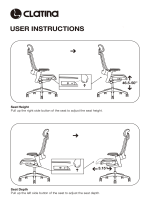
2 3
1 General
The manual must be read thoroughly to avoid damage when handling and using the Next chair.
is a warning triangle to indicate that special care should be taken.
(!) provides advice and tips worth considering
Anti-tips available as an accessory. These prevent the wheelchair from tipping backwards.
We recommend all users to use the anti-tip devices,
unless you are an experienced user with absolute control over your wheelchair.
The tool kit contains: 1 Allen key 5 mm. Settable= Adjusted using tools
1 Ring spanner 24 mm. Adjustable= Adjusted without tools
Next is a manual, cross-folded, allround wheelchair with multiple functions that is intended for use both outdoors
and indoors.
The seat is adjustable in height, angle and depth. The backrest is adjustable in height, angle and shape. The foot-
rests are adjustable in height, angle and depth.
Next can be supplemented and adjusted if needs change. A large range of options and accessories are available:
Various types of backrest and legrest, fixing points for transport in mobility service buses, anti-tips, and various
types of handrims and brakes etc.
Next has the best prerequisites to create comfort, functionality and good manoeuvrability.
Crash test
Etac’s wheelchairs are tested and approved in accordance with ISO 7176-19 and ISO 10542. These ISO stand-
ards specify requirements for the design of the wheelchair’s restraint points, how the wheelchair and the user
are secured in the vehicle, and also describe how tests should be carried out and how the test results should be
interpreted.
Etac’s wheelchairs are crash tested at the Technical Research Institute of Sweden.
The test was performed with normal settings on the wheelchair and with the transport attachment accessory
(see manual). An UNWIN_WWR/ATF/K/R restraining device and an UNWIN_WWR/HD/ATF/K/R 3-point belt were
used in the test.
Etac’s positioning belt and headrest should be used when travelling in vehicles.
Seat widths: From 35 cm to 57.5 cm.
Seat depth: Short frame 36-42 cm. Long frame 42-48 cm.
Functional seat depth : Short frame 42-48 cm. Long frame 48-54 cm.
Max. user weight: 135 kg.
Next with short frame is delivered with the rear wheels mounted. With long frame models the rear wheels are
unmounted.
Service life: The product is tested and fulfils the demands stated in EN 12183. The main product’s durability
and lifetime is at least five years when used in accordance with intended use, the safety instructions, the recon-
ditioning manual and instructions for use in the user manual. The main product consists of the chassis for seat
and back support. Additional parts/accessories are handled in accordance with the manual and reconditioning
manual. The actual lifetime can vary, depending on how much and how intensively the product is being used, but
a maximum of 10 years. If the product is intended for use after the service life period specified by Etac, it is the
responsibility of the product owner to ensure product functionality in accordance with the manual and recondi-
tioning instructions. If this cannot be ensured then the product should be taken out of use.
The following methods of surface treatment have been used:
Lacquered surfaces=Polyester powder coating
Non-lacquered aluminium parts=Anodized coating
Non-lacquered steel surfaces=Galvanized
























